AGOMONI! Bangla Chaler Thakur to Chhobiana -- Changing face of Devi Durga idols
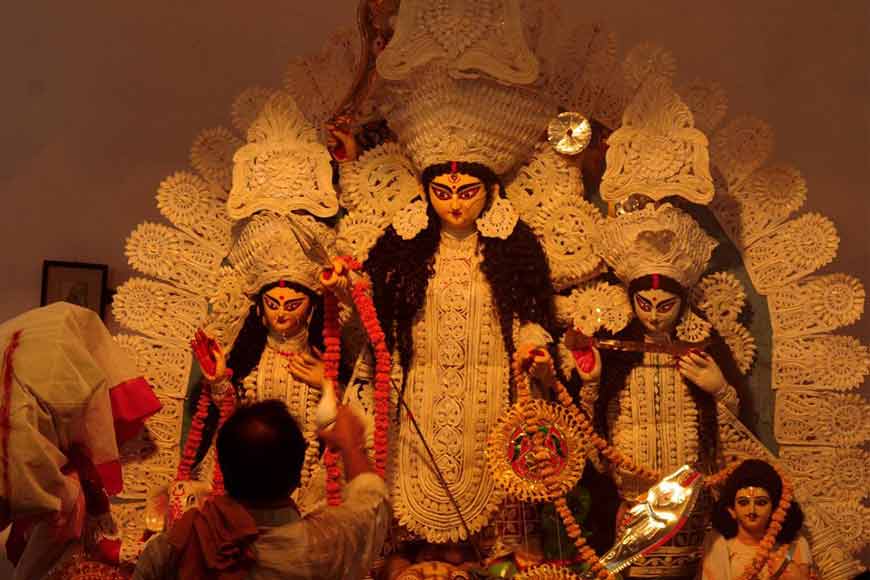
Devi Durga’s idol did not change much in form for over two centuries. This form was quintessentially Bengali in nature, known as ‘Bangla Chaler Thakur.’ Due to constrictions of religious scriptures, even today, ‘Bonedi barir pujo’ or the elite class households of Bengal worship this original form of the idol, where the Goddess is visualised as ‘Destroyer of Evil,’ annihilating the buffalo-demon or Mahisasura. She stands in all her glory at the centre on a frontal frame, flanked by her children, Lakshmi, Saraswati, Kartikeya and Ganesha on a single background structure or chali. Her legs are apart, as she rides her vahana, the mighty lion. Lakshmi and Saraswati are cross-legged, while Ganesha is coloured red. Devi Durga dazzles in glorious golden yellow or she is Atashi Varna, with red alataka border on both her feet, reminding of the bright sunrays and reddish yellow ‘Bramha Rang,’ symbolising reflection of the first rays of the rising sun. Though stylistic variations are restricted in ‘Bangla Chaler Thakur,’ nevertheless, there have been changes in their portrayal over the ages.
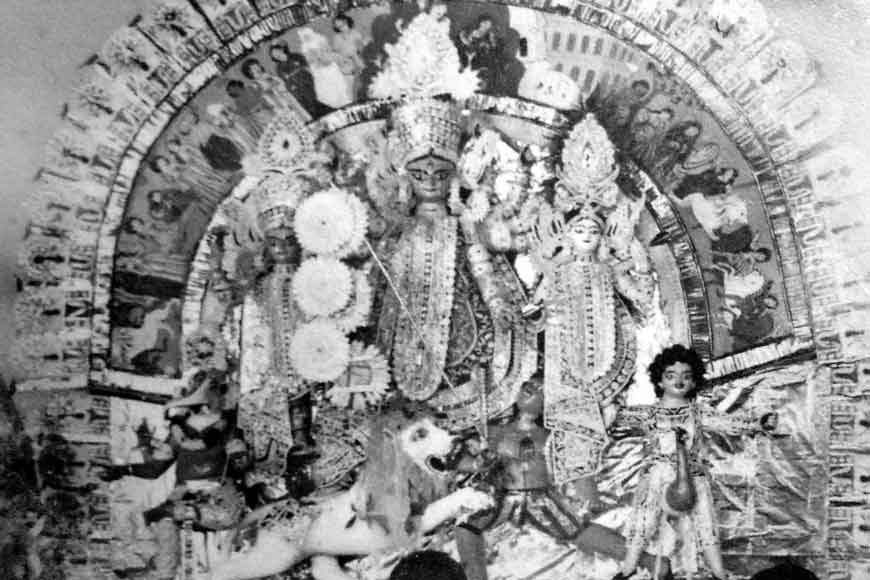 Age-old glory
Age-old glory
Initially, Devi Durga looked like a Bengali bride, with a slender face like a bamboo leaf, known as ‘Khas Bangla Mukh.’ Later, the face grew more round, known as ‘Do Bhasi Mukh’ that finally gave way to a more natural form, known as ‘Chhobiana.’ Post-independence, artists of Kumartuli started experimenting with idols. Kumartuli genre of Durga idol had two categories: Oriental Art er Thakur, initiated by eminent artist, Nitai Charan Pal and Realistic Genre, of Gopeshwar Paul. The innovations rode on skilful strokes of various artisans like Niranjan Pal, Gorachand Pal, Mohan Banshi Rudrapal, Rakhal Pal and Ramesh Pal. Ramesh Pal brought drastic changes in architectural pattern of Puja mandapa, assimilating various forms of Indian architectural elements.
Durga idol is a mark of assimilation and amalgamation, and blends both styles: One from Krishnanagar and Nabadwip; the other from ‘Opar Bangla’ or districts of Bangladesh. The stalwarts of the East Bengal tradition were Mohan Banshi Rudra Pal, Rakhal Pal, Gorachand Pal, Pradip Rudra Pal, Kartik Pal and Krishna Pal. The figures they sculpted were voluptuous, the divine splendour reflected on glazing oil as a finishing touch and were more like stone sculptures. While idols from West Bengal, had a tinge of natural aura with rough body edges that avoided application of varnishing oil. After application of final layer of colour on the clay idols, a synthetic varnish called Gham Tel was applied, imparting the final shine.
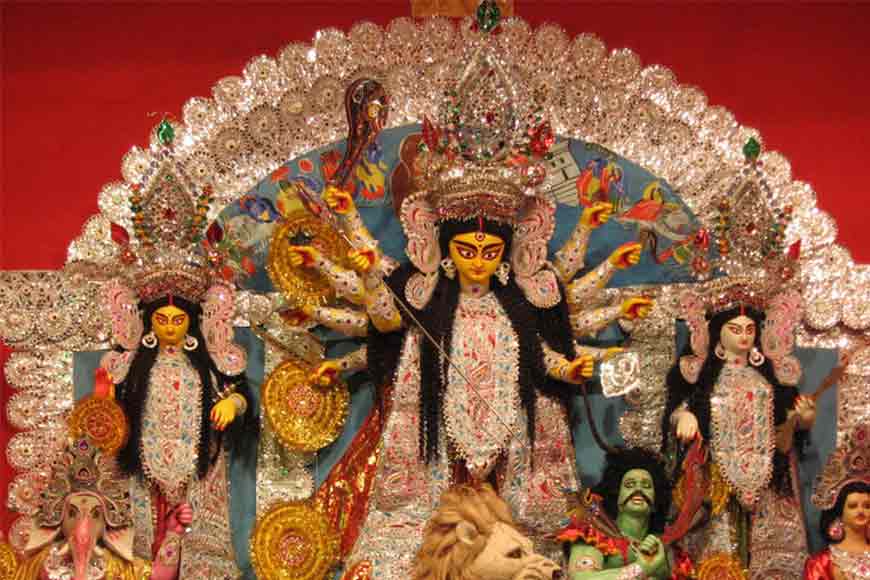 The intricate Chalchitra design works
The intricate Chalchitra design works
Chali shapes also varied, semi-circular or pillared, at times the upper crest was horizontally straight known as tana chouri, or like a crown of a temple, a ratha also known as matha chouri. The Chali had stories painted, that paved the way for a narrative pictorial tradition, known as Chalchitra. The Chalchitra is however not executed by clay-modellers. They have separate artisans and a few original works of Chalchitra artists are still found in Krishnanagar.
Around 19th century, Bengal’s society witnessed a flourishing babu culture, gentlemen who had a lavish lifestyle and sought to attract sympathetic attention of the British lords. The babus found a representation in images of Kartikeya. Kartikeya was the handsome hunk of yesteryears, complete with a kurta, dhoti and a typical turban, same as babu attire. Thus, idols started reflecting sections of the society.
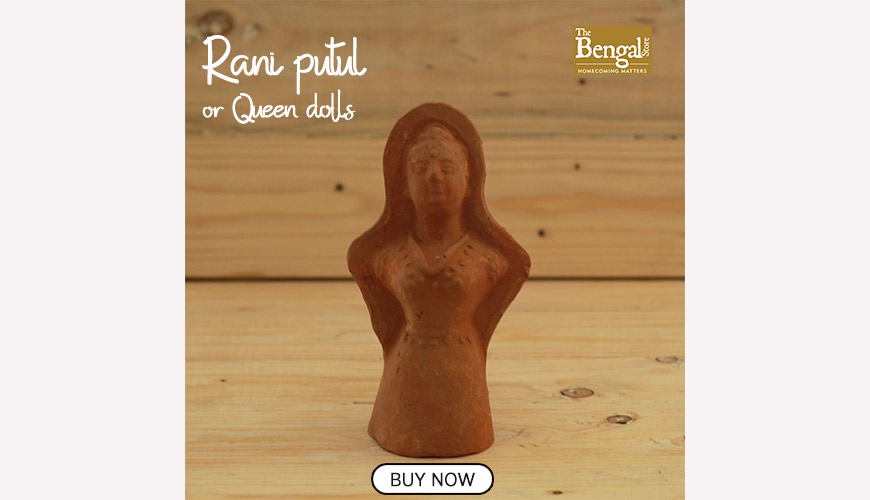 In the traditional Bangla Chaler Thakur, the lion had a hybrid form, with a horse’s face. It had a moustache and was essentially coloured white. Even today, this form of lion is seen in zamindar households like Deb bari, Laha bari, Dawn bari, Khelat Ghosh’s bari. The horse faced lion was imbibed from Dash Avatar Chitra style, seen in the terracotta temple relief. Kumartuli artisans picked up this Nara Simha Avatar’s face for sculpting the lions.
In the traditional Bangla Chaler Thakur, the lion had a hybrid form, with a horse’s face. It had a moustache and was essentially coloured white. Even today, this form of lion is seen in zamindar households like Deb bari, Laha bari, Dawn bari, Khelat Ghosh’s bari. The horse faced lion was imbibed from Dash Avatar Chitra style, seen in the terracotta temple relief. Kumartuli artisans picked up this Nara Simha Avatar’s face for sculpting the lions.
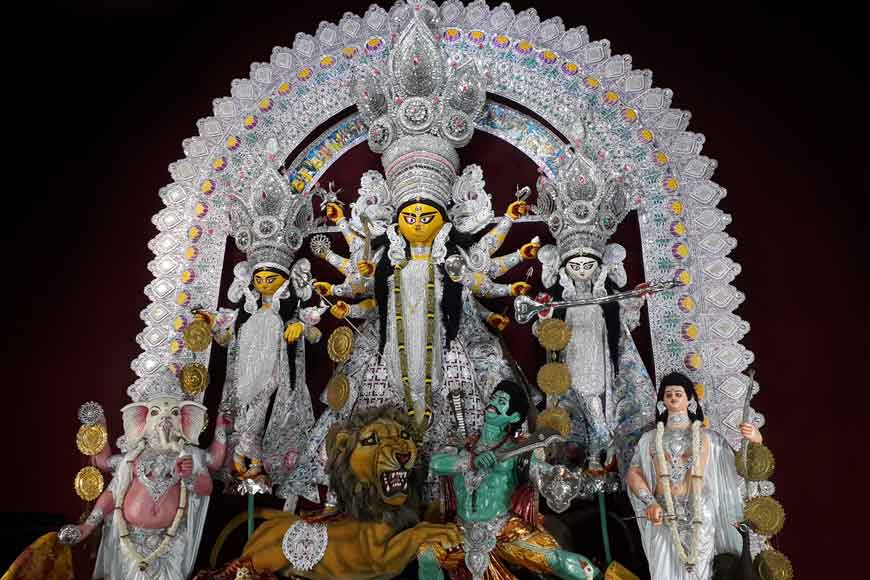 The detailed ornamentation adds on to the beauty of the Goddess
The detailed ornamentation adds on to the beauty of the Goddess
But the European lion soon made its way into Kumartuli, with establishment of a lion figure atop the gate of Raj Bhavan or Governor House, symbolising expansion of Queen Victoria’s empire and British imperialism. Since then, this lion form gained popularity and was given an aggressive look with a bunch of mane, attacking evil Mahisasura. Were artisans of Kumartuli then influenced by the colonial regime and couldn’t come out of their captivity? Well, this will probably remain as an unanswered query.
However, Kumartuli artisans have been influenced by various concepts on and off. Bengali acrobats of early 20th-century lead to the muscular frame of the asura. The myriad imageries of a circus were also used. The popular medium of film paved its way into image making and artisans experimented with facial expressions of famous film stars. Hema Malini as Devi Saraswati or Uttar Kumar as Kartikeya was not unknown.
During reign of Lord Clive, Druga Puja reached its popular heights, but the grandeur of the celebrations became obvious under Warren Hastings. Renowned artists like Ramesh Pal amalgamated European sculpture with its Indian counterpart. Gorachand Pal made Durga look like a Bengali mother with loosened hair, draping her in a red bordered white saree like a village damsel. While, Mohon Banshi Rudrapal rained her with gorgeous strokes and she became the grand idol with profuse use of ‘Daker Saaj.’
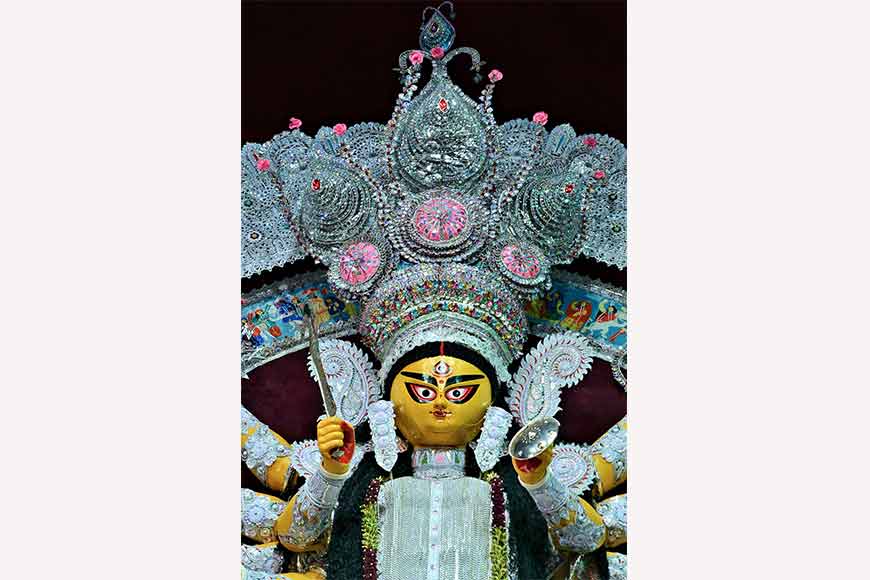 Daker Saaj--A traditional form
Daker Saaj--A traditional form
Even Battala woodcuts in their pictorial rendition of Devi Durga, influenced clay-modelling of Kumartuli, especially in making of ornaments and apparels. The woodcut was a whole new form of artistic genre in the then Kolkata, practised by Muslim artisans. Hence ornament decorations showed Islamic influence. Since ornaments reached Kumartuli by post (post in Bengali is ‘Dak’) from Krishnanagar, they were named as ‘Daker Saaj.’ Several workshops of this handicraft still exist in Santipur, Bagachhra (Nadia) Sonarpur, Baruipur and Joynagar. Down the ages, individual artistic expressions culminated in the idol of Devi Durga, finally paving the way for a unique vision through modern-day ‘Theme Pujas,’ that synchronises idols and the pandal premise.
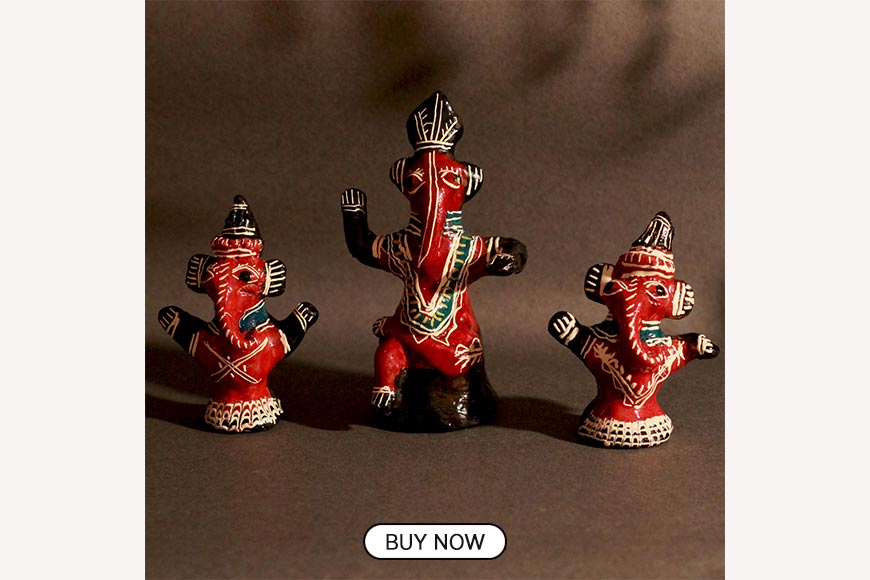 Kumartuli, is not just the arena of creation, but carries tales of the creator and aroma of the medium. Artisans are bearers of tradition and customs, who have survived the test of time. During 17th-18th century, potters’ community crowded around Chitpore to serve as idol makers to elite households. Scope of economic growth turned them idol makers and the area got a new dimension.
Kumartuli, is not just the arena of creation, but carries tales of the creator and aroma of the medium. Artisans are bearers of tradition and customs, who have survived the test of time. During 17th-18th century, potters’ community crowded around Chitpore to serve as idol makers to elite households. Scope of economic growth turned them idol makers and the area got a new dimension.









